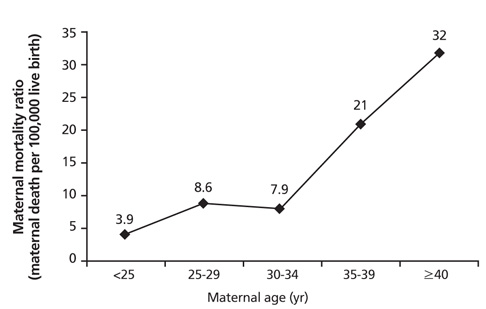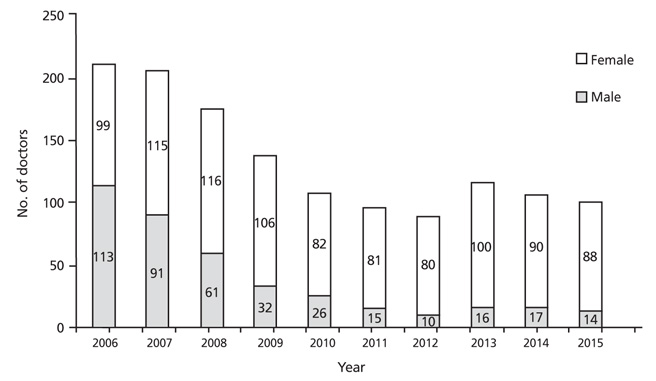The collapse of infrastructure for childbirth: causes and consequences
- Affiliations
-
- 1Department of Obstetrics and Gynecology, Samsung Medical Center, Sungkyunkwan University School of Medicine, Seoul, Korea. ohsymd@skku.edu
- KMID: 2305541
- DOI: http://doi.org/10.5124/jkma.2016.59.6.417
Abstract
- Despite low childbirth rate in Korea, the number of women with high-risk pregnancies is steadily increasing, mostly due to increased maternal age, multiple pregnancies, and obesity. In fact, one out of five Korean women is above 35 years old at childbirth. It is well known that high risk pregnancy is closely related with increased maternal mortality, either by direct or indirect causes. Despite such problems, however, Korea's health care infrastructure for childbirth has deteriorated, leaving approximately 20% of the geographic area of the country medically underserved with regard to optimal maternity care. Such a collapse has been caused by the decrease in the number of maternity hospitals and their financial difficulties due to medical fee reimbursement for childbirth being too low. The problem is aggravated by a lack of obstetricians who can provide skilled attendance at childbirth. In addition, extensive legal pressure has dissuaded talented medical students from pursuing obstetrics and gynecology, thereby resulting in aging and severe gender imbalance in such professions. The direct consequence of the collapse in infrastructure for childbirth is an increased maternal mortality ratio, especially in underserved areas. Moreover, increased maternal death caused by postpartum bleeding reflects an obvious sign of danger in the maternal health care system. Furthermore, the number of tertiary hospitals that can provide optimal care to high risk pregnant women has decreased to two-thirds of what it once was, and the training of competent obstetricians for the mothers of the future continues to be a difficulty.
Keyword
MeSH Terms
-
Aging
Aptitude
Delivery of Health Care
Fees, Medical
Female
Gynecology
Hemorrhage
Hospitals, Maternity
Humans
Korea
Maternal Age
Maternal Death
Maternal Health
Maternal Mortality
Medically Underserved Area
Mothers
Obesity
Obstetrics
Obstetrics and Gynecology Department, Hospital
Parturition*
Postpartum Period
Pregnancy
Pregnancy, High-Risk
Pregnancy, Multiple
Pregnant Women
Students, Medical
Tertiary Care Centers
Figure
Cited by 4 articles
-
2020 Year of the nurse and the midwife: a call for strengthening midwifery in response to South Korea’s ultra-low birth rate
Yun Mi Kim
Korean J Women Health Nurs. 2020;26(4):255-259. doi: 10.4069/kjwhn.2020.12.03.Summary of clinically diagnosed amniotic fluid embolism cases in Korea and disagreement with 4 criteria proposed for research purpose
Jin-ha Kim, Hyun-Joo Seol, Won Joon Seong, Hyun-Mee Ryu, Jin-Gon Bae, Joon Seok Hong, Jeong Yang, Ji-Hee Sung, Suk-Joo Choi, Soo-young Oh, Cheong-Rae Roh
Obstet Gynecol Sci. 2021;64(2):190-200. doi: 10.5468/ogs.20195.Revaluation of measures in obstetrically underserved area
Yoon Ha Kim
J Korean Med Assoc. 2016;59(6):414-416. doi: 10.5124/jkma.2016.59.6.414.Development and Application of a Delivery Infrastructure Collapse Risk Assessment Tool: A Focus on Metropolitan Metropolitan Areas
Hye Mi Ahn, Hyo-Seon Jeong, Jin-Ok Han, Jong Yun Hwang, Heeyoung Lee
J Korean Matern Child Health. 2024;28(4):156-166. doi: 10.21896/jkmch.2024.28.4.156.
Reference
-
1. Statistics Korea. Complementary investigations on the infant, maternal, and perinatal mortality [Internet]. Daejeon: Statistics Korea;2014. cited 2016 March 10. Available from: http://kostat.go.kr.2. Chung SH, Seol HJ, Choi YS, Oh SY, Kim A, Bae CW. Changes in the cesarean section rate in Korea (1982-2012) and a review of the associated factors. J Korean Med Sci. 2014; 29:1341–1352.
Article3. Kim JK. Fall of maternal health care system: as two OBGYN hospitals shut down as one opens. The Korean Doctor's Weakly. 2013. 10. 03. cited 2016 May 10. Available from: http://www.docdocdoc.co.kr/140425.4. Korean Society of Obstetrics and Gynecology. The evaluation of supporting methods for reliable antenatal care and birth for pregnant women in obstetrically underserved area [Internet]. Seoul: Ministry of Health and Welfare;2013. cited 2016 March 10. Available from: http://www.prism.go.kr/homepage/entire/retrieveEntireDetail.do?pageIndex=1&research_id=1351000-201300210&leftMenuLevel=160&cond_research_name=%EB%B6%84%EB%A7%8C&cond_research_start_date=&cond_research_end_date=&pageUnit=10&cond_order=1.5. Moon JL. Establishment of safe birth environment for coping with low birth: sensible reform in obstetric no-fault compen-sation system[Internet]. Seoul: National Assembly Library;2013. cited 2016 May 10. Available from: http://ampos.nanet.go.kr:7000/srchDetail.do?controlNo=PAMP1000036881&ermType=PDF&query=%EB%B6%84%EB%A7%8C&menuId=all&docPage=1&sortSpec=SEMINAR_DIV_CODE%20asc,%20HOST_DT_FROM%20desc,%20title%20asc&sub_assembly_th=&sub_congress_name=&sub_congress_list=&keyword_L=&opentime_L=&opentimeFrom_L=&opentimeTo_L=&member_L=&theme_L=&assemblyth_L=&hostplace_L=&docSize=10&tabSeminarDivCode=10.6. Cho MK. The financial difficulty in hospitals in obstetrically underserved area supported by national supporting program. Kuki News. 2014. 10. 14. cited 2016 May 10. Available from: http://news.kukinews.com/article/view.asp?arcid=0008761634&code=46111201&cp=nv.7. Choi JS, Seo K, Lee NH, Kim SY, Lee SU, Lee SU, Pu YK. Infant and maternal death survey report in 2007-2008. Seoul: Ministry of Health and Welfare;2010.8. Sullivan SA, Hill EG, Newman RB, Menard MK. Maternal-fetal medicine specialist density is inversely associated with maternal mortality ratios. Am J Obstet Gynecol. 2005; 193(3 Pt 2):1083–1088.
Article9. National Health Insurance Service. Review records of delivery by provider type, 2012-2014 [Internet]. Wonju: Korean Statistical Information Service;2015. cited 2016 March 10. Available from: http://kosis.kr/statHtml/statHtml.do?orgId=354&tblId=DT_LEE_54&vw_cd=MT_ZTITLE&list_id=354_1_F&seqNo=&lang_mode=ko&language=kor&obj_var_id=&itm_id=&conn_path=E1.10. Health Insurance Review and Assessment Service. Cesarean section records by provider type of medical institutions, 2007-2012 [Internet]. Wonju: Korean Statistical Information Service;2014. cited 2016 March 10. Available from: http://kosis.kr/statHtml/statHtml.do?orgId=354&tblId=TX_354_2009_H1012&vw_cd=MT_ZTITLE&list_id=354_35402&seqNo=&lang_mode=ko&language=kor&obj_var_id=&itm_id=&conn_path=E1.11. Lee GY. Establishment of health care delivery system between the integrated center for high-risk pregnant women and neo-nates and the maternity care in the underserved area [Internet]. Sejong: Ministry of Health and Welfare;2015. cited 2016 March 10. Available from: http://www.prism.go.kr/homepage/theme/retrieveThemeDetail.do;jsessionid=7EC0F0966B138834D8579F682B438191.node02?cond_research_name=&cond_organ_id=&cond_research_year_start=&cond_research_year_end=&cond_brm_super_id=NB000120061201100060495&research_id=1351000-201500314&pageIndex=8&leftMenuLevel=110.
- Full Text Links
- Actions
-
Cited
- CITED
-
- Close
- Share
- Similar articles
-
- Development and Application of a Delivery Infrastructure Collapse Risk Assessment Tool: A Focus on Metropolitan Metropolitan Areas
- Childbirth Experience of Participants in Lamaze Childbirth Education
- Do childbirth confidence, prenatal depression, childbirth knowledge, and spousal support influence childbirth fear in pregnant women?
- Almost 80 Years After Hiroshima and Nagasaki: Are World Governments and Healthcare Systems Ready for a Nuclear War?
- Effects of a One Session Spouse-Support Enhancement Childbirth Education on Childbirth Self-Efficacy and Perception of Childbirth Experience in Women and their Husbands






